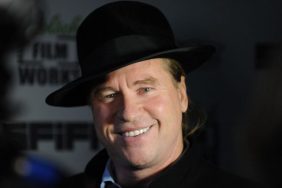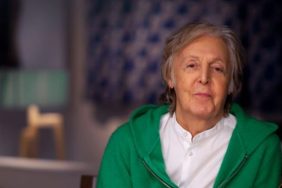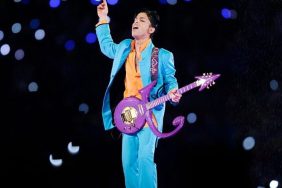Artwork: (L.) The Chambers Brothers (The Matrix, 28 March–6 April 1967), 1967, Victor Moscoso. (R.) The Yardbirds, The Doors, James Cotton Blues Band, Richie Havens (Fillmore Auditorium, 25–30 July 1967), 1967, Bonnie MacLean.
If you have ever eaten one too many shrooms, you may have discovered what happens when the senses connect in profound new ways. Synaesthesia, as the phenomenon is formally known, is the result of having two senses collide and transport you into another realm. For example, sight and sound meet and meld, create a corresponding relationship between the two senses. Every sound can be seen, every sight can be heard so much so you might wonder, “Does this exist in the sober world?”
Also: Celebrate the 50th Anniversary of the “Summer of Love”
Back here, in the land of no drugs, most of us return to our quietly compartmentalized experiences of life. But every now and then, a movement breaks through, a style so rich, so layered, and so entirely new that it allows us to break through the boundaries of perception. This is what the Summer of Love did, fifty years ago.

Haight Street 1967 (Plate 20). Herb Greene (American, born in 1942), 1967, printed 2013. Photograph, gelatin silver print. Private collection. Courtesy, Museum of Fine Arts, Boston.
San Francisco’s Haight-Ashbury became the mecca for an emerging movement of radical youth who could not bare to live by the confines and strictures that the 1950s imposed. They loathed the phony morality and the corny formalism that society spackled over to a host of horrors in the form of apartheid laws and the oppression of basic human rights. They disavowed themselves of the fear and paranoia that created McCarthyism and the Vietnam War. They rejected the culture of hatred that was embroiled in the systems of racism, sexism, and homophobia.
In place of the plastic they sought substance, willing to reject, rebel, and reinvent a world founded in love. Granted, they were naïve, but that’s the beauty of youth: because you aren’t burdened with the weight of experience and history, you’re an optimist. You can be willing to risk it all because you refuse to hold back.
“Freedom’s just another word for nothing left to lose,” Janis Joplin sang on “Me and Bobby McGee,” tapping the raw power of reality. She, and artists like Jefferson Airplane, The Grateful Dead, The Doors, Buffalo Springfield, and Iron Butterfly, as well as blues legends Bo Diddley, Muddy Waters, and John Lee Hooker were playing weekly shows that spoke to the times.
Strobe lights flashed and avant-garde films were projected on the walls, while the musicians performed on stage, creating an immersive environment that pushed your senses to the outer limits. They hung poster for the shows at local shops and on telephone poles, using psychedelic designs and bold, high-contrast color schemes to catch your eye and hold it for ransom.

Grateful Dead, Oxford Circle (Avalon Ballroom, 16–17 September 1966). Stanley Miller (Mouse) (American, born in 1940). Alton Kelley (American, 1940–2008). After: Edmund J. Sullivan (English, 1869–1933), 1966. Poster, offset lithograph. Collection of Patrick Murphy. Courtesy, Museum of Fine Arts, Boston.
Now, the Museum of Fine Arts Boston presents a selection of these historic works in The Summer of Love: Photography and Graphic Design on view through October 22, 2017.
The centerpiece of the exhibition features 32 photographs by Herb Greene, a pioneering member of the Haight-Ashbury counterculture who worked as one of the Grateful Dead’s principal photographers since the band’s inception. His access allowed him to create a veritable who’s who in black and white.
A selection of psychedelic show posters creates the perfect counterpoint to Greene’s crisp portraits and documentary scenes. The Summer of Love features works by Wes Wilson, who produced about 60 posters for the Fillmore during its first year of operation, setting the bar and defining the look of the era. Inspired by Vienna Secession poster designer Alfred Roller, Wilson’s typographic experiments subverted the norms of mainstream advertising, creating intentionally challenging images that would not easily be deciphered by the mainstream.
Complementing these works are posters made for the Avalon Ballroom by Victor Moscoso, who studied color theory with Joseph Albers at Yale and put those lessons to good use, and the team of Mouse and Kelley, who specialized in the appropriation of “old-timey” art, making references to Alphonse Mucha and Edgar Allen Poe updated for the new generation.
Then finally there is an astounding grid of 25 album covers that trace the influence of the amorphous lettering that appeared on the Beatles 1965 album, Rubber Soul, and looks at how it had been adopted and adapted during the second half of the decade. Everyone is here: Chuck Berry, the Jimi Hendrix Experience, Country Joe & the Fish, Donovan, and Dusty Springfield. There’s even an album titled “L.S.D.” by Dr. Timothy Leary Ph.D., the man who kicked off the Summer of Love with the Human Be-In at Golden Gate Park.
But perhaps the piece de resistance are the offset lithograph posters of Richard Avedon of each member of the Beatles, commissioned by manager Brian Epstein. The posters were distributed in England by the Daily Express newspaper, and on the continent by the German magazine Stern (the edition shown here). In the United States, they appeared for sale in the January 9, 1968 issue of Look magazine, with Avedon’s image of John Lennon on the cover. Inside were full-page reproductions and a mail order form. Can you imagine spending just $1.50 for each poster, or $5.95 for the complete set of five? Once upon a time anybody could afford to buy an Avedon. Such was the Summer of Love …
Miss Rosen is a journalist covering art, photography, culture, and books. Her byline has appeared in L’Uomo Vogue, Vogue Online, The Undefeated, Dazed Digital, Aperture Online, and Feature Shoot. Follow her on Twitter @Miss_Rosen.
The Summer of Love MFA Boston
-
"The Summer of Love: Photography and Graphic Design" Exhibit

Jefferson Airplane, Surrealistic Pillow. Photographer: Herb Greene (American, born in 1942), 1967. Album cover, offset lithograph. Collection of Patrick Murphy. Courtesy, Museum of Fine Arts, Boston.
-
"The Summer of Love: Photography and Graphic Design" Exhibit

Jefferson Airplane, Herb Greene (American, born in 1942), 1966. Photograph, gelatin silver print. Gift of Arlette and Gus Kayafas and The Living New England Artists Purchase Fund, created by The Stephen and Sybil Stone Foundation © Herb Greene. Photograph © Museum of Fine Arts, Boston.
-
"The Summer of Love: Photography and Graphic Design" Exhibit

Jefferson Airplane, Junior Wells Chicago Blues Band, Tim Rose (16–18 December 1966). Wes Wilson (American, born in 1937), 1966. Offset lithographic poster. Gift of Robert Bradford Wheaton and Barbara Ketcham Wheaton. Photograph © Museum of Fine Arts, Boston.
-
"The Summer of Love: Photography and Graphic Design" Exhibit

Jefferson Airplane, Grateful Dead (Fillmore Auditorium, 12–13 August 1966). Wes Wilson (American, born in 1937). Photographer: Herb Greene (American, born in 1942), 1966. Poster, offset lithograph. Collection of Patrick Murphy. Courtesy, Museum of Fine Arts, Boston.
-
"The Summer of Love: Photography and Graphic Design" Exhibit

Ohio to San Francsico: Haight Street 1967 (Plate 17). Herb Greene (American, born in 1942) 1967, printed 2013. Photograph, gelatin silver print. Private collection. Courtesy, Museum of Fine Arts, Boston.
-
"The Summer of Love: Photography and Graphic Design" Exhibit

Muddy Waters, Buffalo Springfield, Richie Havens (1–6 August 1967). Bonnie MacLean (American, born in 1939), 1967. Offset lithographic poster. Gift of Robert Bradford Wheaton and Barbara Ketcham Wheaton* Photograph © Museum of Fine Arts, Boston
-
"The Summer of Love: Photography and Graphic Design" Exhibit

The Chambers Brothers at the Matrix (28–30 March, 4–6 April 1967). Victor Moscoso (American, born in Spain, 1936), 1967. Offset lithographic poster. Gift of Robert Bradford Wheaton and Barbara Ketcham Wheaton. © '67 Neon Rose. Photograph © Museum of Fine Arts, Boston.
-
"The Summer of Love: Photography and Graphic Design" Exhibit

Ohio to San Francsico: Haight Street 1967 (Plate 30), Herb Greene (American, born in 1942), 1967, printed 2013Photograph, gelatin silver print. Private collection. Courtesy, Museum of Fine Arts, Boston.
-
"The Summer of Love: Photography and Graphic Design" Exhibit

Moby Grape, Sparrow, The Charlatans (Avalon Ballroom, 13–14 January 1967). Stanley Miller (Mouse) (American, born in 1940). Alton Kelley (American, 1940–2008), 1967. Poster, offset lithograph. Collection of Patrick Murphy. Courtesy, Museum of Fine Arts, Boston.
-
"The Summer of Love: Photography and Graphic Design" Exhibit

Grateful Dead, Oxford Circle (Avalon Ballroom, 16–17 September 1966). Stanley Miller (Mouse) (American, born in 1940). Alton Kelley (American, 1940–2008). After: Edmund J. Sullivan (English, 1869–1933), 1966. Poster, offset lithograph. Collection of Patrick Murphy. Courtesy, Museum of Fine Arts, Boston.
-
"The Summer of Love: Photography and Graphic Design" Exhibit

Brief Encounters with the Dead: Dead On. Herb Greene (American, born in 1942) 1967, printed 2006. Gelatin silver print. Collection of Jeanne and Richard S. Press. Courtesy, Museum of Fine Arts, Boston.
-
"The Summer of Love: Photography and Graphic Design" Exhibit

The Yardbirds, The Doors, James Cotton Blues Band, Richie Havens (Fillmore Auditorium, 25–30 July 1967). Bonnie MacLean (American, born in 1939), 1967. Poster, offset lithograph. Collection of Patrick Murphy. Courtesy, Museum of Fine Arts, Boston.
-
"The Summer of Love: Photography and Graphic Design" Exhibit

Haight Street 1967 (Plate 20). Herb Greene (American, born in 1942), 1967, printed 2013. Photograph, gelatin silver print. Private collection. Courtesy, Museum of Fine Arts, Boston.
-
"The Summer of Love: Photography and Graphic Design" Exhibit

Ver Sacrum Kalender 1903. Illustrated by: Alfred Roller (Austrian, 1864–1935). Illustrated by: Friedrich König (Austrian, 1857–1941). Illustrated by: Ferdinand Andri (Austrian, 1871–1956)Illustrated by: Emil Orlik (Czech, 1870–1932)I. llustrated by: Wilhelm List (Austrian, 1864–1919).Illustrated by: Koloman Moser (Austrian, 1868–1918). Illustrated by: Leopold Stolba (Austrian, 1863–1929). Illustrated by: Elena Luksch‑Makovsky (Austrian, 1878–1967). Illustrated by: Karl Müller (German). Illustrated by: Maximilian Kurzweil (Austrian, born in Moravia, 1867–1916). Illustrated by: Rudolf Jettmar (Polish, 1869–1939), August1902. Illustrated book containing 12 monthly calendars, each accompanied by a figurative two‑color woodcut image printed from stereotypes. Museum of Fine Arts, Boston. William A. Sargent Fund. Photograph © Museum of Fine Arts, Boston.








